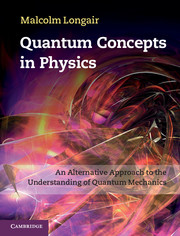Book contents
- Frontmatter
- Contents
- Preface
- Acknowledgements
- Part I The Discovery of Quanta
- Part II The Old Quantum Theory
- 4 The Bohr model of the hydrogen atom
- 5 Sommerfeld and Ehrenfest – generalising the Bohr model
- 6 Einstein coefficients, Bohr's correspondence principle and the first selection rules
- 7 Understanding atomic spectra – additional quantum numbers
- 8 Bohr's model of the periodic table and the origin of spin
- 9 The wave–particle duality
- Part III The Discovery of Quantum Mechanics
- Epilogue
- Notes
- References
- Name index
- Subject index
4 - The Bohr model of the hydrogen atom
from Part II - The Old Quantum Theory
Published online by Cambridge University Press: 05 February 2013
- Frontmatter
- Contents
- Preface
- Acknowledgements
- Part I The Discovery of Quanta
- Part II The Old Quantum Theory
- 4 The Bohr model of the hydrogen atom
- 5 Sommerfeld and Ehrenfest – generalising the Bohr model
- 6 Einstein coefficients, Bohr's correspondence principle and the first selection rules
- 7 Understanding atomic spectra – additional quantum numbers
- 8 Bohr's model of the periodic table and the origin of spin
- 9 The wave–particle duality
- Part III The Discovery of Quantum Mechanics
- Epilogue
- Notes
- References
- Name index
- Subject index
Summary
Following the success of the 1911 Solvay Conference and the rapid dissemination of the proceedings, the emphasis of research shifted towards the understanding of the spectra of atoms and molecules. With the availability of precision spectroscopic techniques, the bewildering variety of spectral features of atoms and molecules became apparent. The efforts described in Sect. 1.6 indicate how regularities were found in the patterns of spectral lines, the culmination of these investigations being the discovery of the formula for the Balmer series and the various formulae to account for the principal, diffuse and sharp series of the lines in the spectra of sodium, potassium, magnesium, calcium and zinc. As Planck remarked in 1902,
‘If the question concerning the nature of white light may thus be regarded as being solved, the answer to the closely related but no less important question – the question concerning the nature of light of the spectral lines – seems to belong among the most difficult and complicated problems, which have ever been posed in optics or electrodynamics.’ (Planck, 1902)
The Zeeman effect: Lorentz and Larmor's interpretations
In 1862, Faraday attempted to measure the change in wavelength of spectral lines when the source of the lines was placed in a strong magnetic field, but failed to observe any positive effect (Jones, 1870). Inspired by this negative result, Pieter Zeeman repeated the experiment and discovered the broadening of the D lines of sodium when a sodium flame was placed between the poles of a strong electromagnet (Zeeman, 1896a).
- Type
- Chapter
- Information
- Quantum Concepts in PhysicsAn Alternative Approach to the Understanding of Quantum Mechanics, pp. 71 - 89Publisher: Cambridge University PressPrint publication year: 2013



